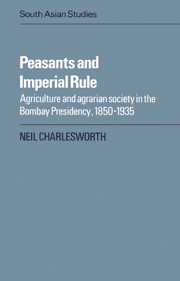Book contents
- Frontmatter
- Contents
- List of maps and tables
- Preface
- Note on technical terms and references
- Maps
- 1 Introduction: the peasant in India and Bombay Presidency
- 2 The village in 1850: land tenure, social structure and revenue policy
- 3 The village in 1850: land and agriculture
- 4 Indebtedness and the Deccan Riots of 1875
- 5 Continuity and change in the rural economy, 1850–1900
- 6 The Bombay peasantry, 1850–1900: social stability or social stratification?
- 7 The agricultural economy, 1900–1935: the critical watershed?
- 8 The impact of government policy, 1880–1935
- 9 The peasant and politics in the early twentieth century
- 10 Conclusions: the problem of differential commercialisation
- Glossary
- Bibliography
- Index
5 - Continuity and change in the rural economy, 1850–1900
Published online by Cambridge University Press: 10 December 2009
- Frontmatter
- Contents
- List of maps and tables
- Preface
- Note on technical terms and references
- Maps
- 1 Introduction: the peasant in India and Bombay Presidency
- 2 The village in 1850: land tenure, social structure and revenue policy
- 3 The village in 1850: land and agriculture
- 4 Indebtedness and the Deccan Riots of 1875
- 5 Continuity and change in the rural economy, 1850–1900
- 6 The Bombay peasantry, 1850–1900: social stability or social stratification?
- 7 The agricultural economy, 1900–1935: the critical watershed?
- 8 The impact of government policy, 1880–1935
- 9 The peasant and politics in the early twentieth century
- 10 Conclusions: the problem of differential commercialisation
- Glossary
- Bibliography
- Index
Summary
Implicit in our whole discussion of the causes of the Deccan Riots and, even, the evolution of official attitudes to the problem of indebtedness has been the central issue of fluctuations within the rural economy. In a society which lived so close to the struggle for subsistence, these short-term changes in economic climate were likely to have substantial, deep-felt impact. Yet, also, they were the very stuff out of which any broader developments in economic performance might be constructed. If for example, the rural economy could enjoy a prolonged period of buoyant demand and favourable climatic conditions, then some important steps might be taken towards extending local supply of capital and credit. On the other hand, even one season of serious famine might create more than short-term crisis, by killing off agricultural stock and hence intensifying crucial limitations of resources. So we need, at this stage, to try to delineate the pattern of economic fluctuations over the whole second half of the nineteenth century.
At the broadest level, this is not difficult. From the 1840s, as we have seen, population, land use and price levels seem to have been rising consistently in western India, although often from fairly low bases. The process then accelerated markedly during the first half of the 1860s. Tytler's comments, for that period, from Ahmednagar District might be applied to most regions of the Presidency: ‘the seasons have been excellent, the market prices very high and the consumption of produce and consequent demand great and increasing’. After about 1870, however, prices and, in some cases, the extent of cultivated acreage began to decline.
- Type
- Chapter
- Information
- Peasants and Imperial RuleAgriculture and Agrarian Society in the Bombay Presidency 1850–1935, pp. 125 - 161Publisher: Cambridge University PressPrint publication year: 1985



